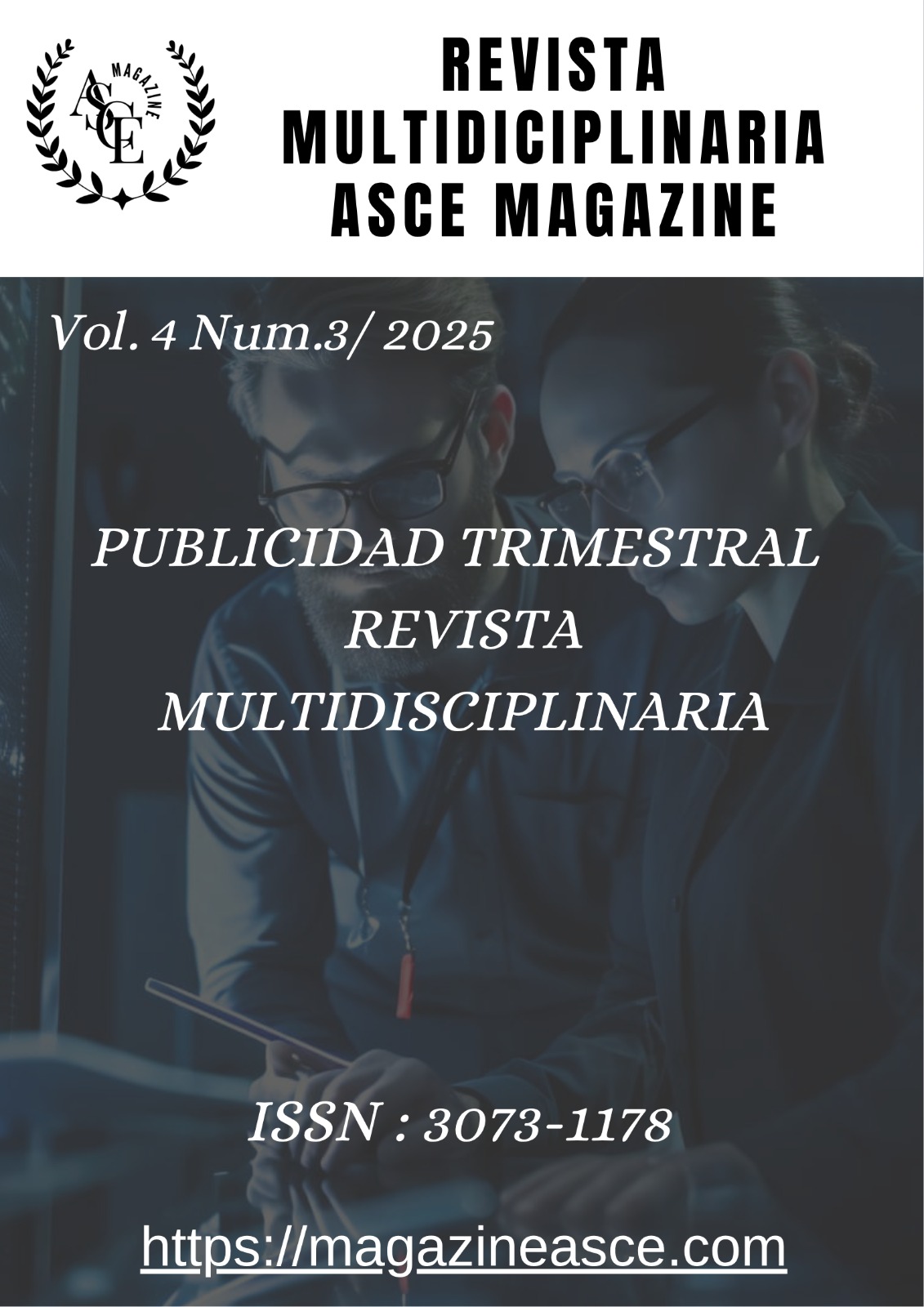Long-acting Contraceptives Post Obstetric Event. Bibliographic review
DOI:
https://doi.org/10.70577/ASCE/1812.1831/2025Keywords:
Contraception; Sex education; Pregnancy; Family planning; Health service.Abstract
Post-obstetric contraception consists of providing methods that establish safe intergenetic periods and prevent unplanned pregnancies. To this end, long-acting reversible contraceptives (LARCs) have proven to be of great importance. Therefore, the available evidence on their implementation after obstetric events was analyzed, describing their characteristics and available types, evaluating their effectiveness, and identifying barriers associated with their insertion. Descriptive bibliographic research was carried out under a narrative review using the PICO question as a conceptual framework and the PRISMA diagram for the elaboration of results. Databases such as PubMed and ScienceDirect were consulted, from which 11 articles from the first quartiles indexed in Scimago Journal Rank (SJR) were selected. In addition to these, a total of 28 bibliographic sources from the last 5 years and statistics from the Ecuadorian Ministry of Public Health were obtained. The review showed a 99% effectiveness rate, which is higher than conventional contraceptive methods, and studies confirmed user satisfaction. Immediate postpartum insertion proved to be safe and effective, with factors such as race and age not affecting the results. However, barriers such as misinformation and cultural and socioeconomic factors persisted, limiting its acceptance. It was concluded that LARCs are an effective strategy for preventing unplanned pregnancies and require reinforcement of sex education, medical counseling, and public health policies that maximize their implementation.
Downloads
References
1. González IA, Salgado LNR, Valencia JAA, Arcos MPT, editors. Planificación familiar en tiempos de COVID-19 [Internet]. Vol. 13. Revista Científica de la Universidad de Cienfuegos; 2021 [cited 2025 July 28]. Available from: http://scielo.sld.cu/scielo.php?script=sci_abstract&pid=S2218-36202021000600583&lng=es&nrm=iso
2. Martínez Pérez A, Terrón Barroso J, Alayón Hernández N, Ariza Chana NE. Métodos anticonceptivos de larga duración (LARC): características de las usuarias, tasa de continuidad y efectividad. Clin Invest Ginecol Obstet. 2023 Jan;50(1):100800. DOI: https://doi.org/10.1016/j.gine.2022.100800
3. Eeckhaut MCW. Can LARC fulfill its potential to reduce U.s. women’s unintended pregnancy risk? Examining women’s contraception and childbearing in the year before initiating LARC. Popul Res Policy Rev. 2022 June;41(3):789–99. DOI: https://doi.org/10.1007/s11113-021-09681-4
4. Gómez Ponce de Leon R, Bahamondes MV, Hellwig F, Barros A, Bahamondes L, Tobar F, et al. Potential of LARC to recover loss in satisfied demand for modern contraception after the COVID-19 pandemic: a case scenario analysis of Brazil and Mexico. Rev Panam Salud Publica. 2022 June 3;46:e41. DOI: https://doi.org/10.26633/RPSP.2022.41
5. Proyecto de Prevención del Embarazo en Niñas y Adolescentes – Ministerio de Salud Pública [Internet]. 2021 [cited 2025 May 2]. Available from: https://www.salud.gob.ec/proyecto-de-prevencion-del-embarazo-en-ninas-y-adolescentes-2/
6. Hidalgo JPG, Jiménez MGG, editors. Factores relacionados con la falta de adherencia al uso de métodos anticonceptivos en mujeres en edad reproductiva [Internet]. Vol. 9. Enfermeria Investiga; 2024 [cited 2025 May 2]. Available from: https://revistas.uta.edu.ec/erevista/index.php/enfi/article/view/2662/3102
7. Rocca ML, Palumbo AR, Visconti F, Di Carlo C. Safety and benefits of contraceptives implants: A systematic review. Pharmaceuticals (Basel). 2021 June 8;14(6):548. DOI: https://doi.org/10.3390/ph14060548
8. Maia EMC, Peixoto RAC, Carvalho FHC, Guazzelli CAF. Adolescents’ contraceptive choice in the immediate postpartum period: A cohort study. J Pediatr Adolesc Gynecol [Internet]. 2025 July 4; Available from: http://dx.doi.org/10.1016/j.jpag.2025.06.011 DOI: https://doi.org/10.1016/j.jpag.2025.06.011
9. Paul R, Huysman BC, Maddipati R, Madden T. Familiarity and acceptability of long-acting reversible contraception and contraceptive choice. Am J Obstet Gynecol. 2020 Apr;222(4S):S884.e1-S884.e9. DOI: https://doi.org/10.1016/j.ajog.2019.11.1266
10. Rosa Bolling K, Wahdan Y, Warnock N, Lott J, Schoendorf J, Pisa F, et al. Utilisation, effectiveness, and safety of immediate postpartum intrauterine device insertion: a systematic literature review. BMJ Sex Reprod Health. 2023 Apr;49(2):e1. DOI: https://doi.org/10.1136/bmjsrh-2022-201579
11. Jensen JT, Lukkari-Lax E, Schulze A, Wahdan Y, Serrani M, Kroll R. Contraceptive efficacy and safety of the 52-mg levonorgestrel intrauterine system for up to 8 years: findings from the Mirena Extension Trial. Am J Obstet Gynecol. Elsevier BV; 2022 Dec;227(6):873.e1-873.e12. DOI: https://doi.org/10.1016/j.ajog.2022.09.007
12. Hogmark S, Liljeblad KL, Envall N, Gemzell-Danielsson K, Kallner HK. Placement of an intrauterine device within 48 hours after early medical abortion-a randomized controlled trial. Am J Obstet Gynecol. 2023 Jan;228(1):53.e1-53.e9. DOI: https://doi.org/10.1016/j.ajog.2022.07.063
13. Moniz MH, Dalton VK, Smith RD, Owens LE, Landis-Lewis Z, Peahl AF, et al. Feasibility and acceptability of a toolkit-based process to implement patient-centered, immediate postpartum long-acting reversible contraception services. Am J Obstet Gynecol. 2022 Mar;226(3):394.e1-394.e16. DOI: https://doi.org/10.1016/j.ajog.2021.10.009
14. Darney BG, Biel FM, Oakley J, Rodriguez MI, Cottrell EK. US “safety net” clinics provide access to effective contraception for adolescents and young women, 2017-2019. Am J Public Health. 2022 June;112(S5):S555–62. DOI: https://doi.org/10.2105/AJPH.2022.306913
15. Guiahi M. Immediate postpartum long-acting reversible contraception: An effective and underutilized strategy. JAMA Netw Open. American Medical Association (AMA); 2022 Oct 3;5(10):e2238098. DOI: https://doi.org/10.1001/jamanetworkopen.2022.38098
16. Lichtenstein Liljeblad K, Kopp Kallner H, Brynhildsen J, Kilander H. Women’s experiences of postpartum contraceptive services when elective caesarean section is the method of birth: a qualitative study. BMJ Sex Reprod Health. 2024 Apr 11;50(2):107–13. DOI: https://doi.org/10.1136/bmjsrh-2023-202046
17. Tyson N, Romano M. Anticoncepción: Panorama de las cuestiones específicas de los adolescentes. UpToDate; 2024.
18. Nalini N, Singh B, Jha S, Singh AV. Acceptance, safety and efficacy of postpartum intrauterine contraceptive device. J Family Med Prim Care. 2023 May;12(5):868–73. DOI: https://doi.org/10.4103/jfmpc.jfmpc_1392_22
19. Iqbal M, Wasim T, AlQahtani SA, Alghamdi AA, Ahmad A, Abbas AH, et al. The thematic analysis of barriers to immediate post-partum long-acting reversible contraception. Healthcare (Basel). 2024 Nov 5;12(22):2208. DOI: https://doi.org/10.3390/healthcare12222208
20. Gallagher MC, Morris CN, Fatima A, Daniel RW, Shire AH, Sangwa BMM. Immediate postpartum long-acting reversible contraception: A comparison across six humanitarian country contexts. Front Glob Womens Health. 2021 Apr 6;2:613338. DOI: https://doi.org/10.3389/fgwh.2021.613338
21. Guilbert E, Arguin H, Bélanger M. Extended duration of use of long-acting reversible contraceptives: Systematic review. Can Fam Physician. 2025 Feb;71(2):e35–52. DOI: https://doi.org/10.46747/cfp.7102e35
22. Henke L, Martins S, Boraas C. Associations between income status and perceived barriers to using long-acting reversible contraception: An exploratory study. Front Reprod Health. 2022 Apr 12;4:856866. DOI: https://doi.org/10.3389/frph.2022.856866
23. Mazza D, Assifi AR, McGeechan K, Haas M, Peipert JF, Lucke J, et al. Increasing the uptake of long-acting reversible contraception through family practice: the Australian Contraceptive ChOice pRoject (ACCORd) cluster randomized controlled trial 3-year follow-up. Am J Obstet Gynecol [Internet]. 2025 Mar 20; Available from: http://dx.doi.org/10.1016/j.ajog.2025.03.020 DOI: https://doi.org/10.1016/j.ajog.2025.03.020
24. Zuheros Montes JD, Nieto Espinar Y, Zuheros Montes MC. Estudio descriptivo sobre la satisfacción de las usuarias de Implanon® y los motivos para su retirada. Clin Invest Ginecol Obstet. 2023 Apr;50(2):100825. DOI: https://doi.org/10.1016/j.gine.2022.100825
25. Shrestha S, Hannah F. Improving access to long-acting reversible contraception in the primary care setting. J Nurse Pract. 2024 May;20(5):104988. DOI: https://doi.org/10.1016/j.nurpra.2024.104988
26. Marcelino AC, Pereira P da C, Bahamondes L. The economic impact of Long-Acting Contraceptives (LARCs) on public health. Clinics (Sao Paulo). 2025 Feb 19;80:100598. DOI: https://doi.org/10.1016/j.clinsp.2025.100598
Downloads
Published
How to Cite
Issue
Section
License
Copyright (c) 2025 Karla Merari Monge Roque, Ariana Belén Benenaula Cabrera, Sixto Isaac Chiliquinga Villacís

This work is licensed under a Creative Commons Attribution-NonCommercial-NoDerivatives 4.0 International License.






























